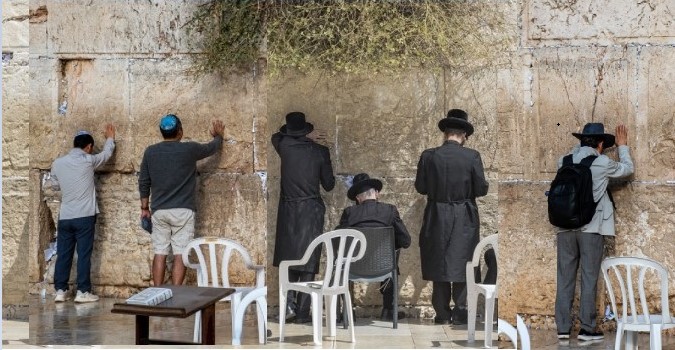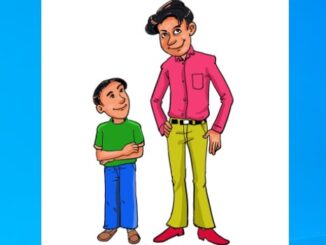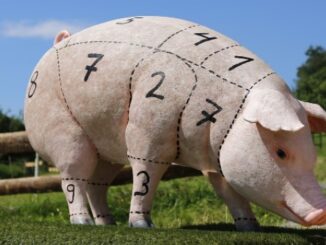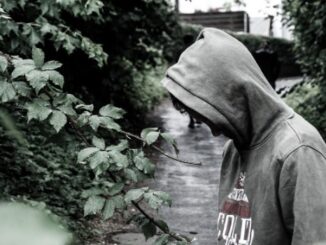
Are you a Torah Jew or Tznius Jew the two don’t go together.
Hashem created man without clothes. It was only after Adam and Chava ate from the עץ הדעת tree of knowledge that the Torah says they became aware that they were naked so they took leaves to cover the private parts.
Only after this incident, did Hashem make clothing for both husband and wife out of animal skin, leather.
In Parshas Bereishis Chapter 3:7 it says:
ותפקחנה עיני שניהם וידעו כי עירמם הם ויתפרו עלה תאנה ויעשו להם חגרת
Then the eyes of both of them were opened and they perceived that they were naked; and they sewed together fig leaves and made themselves cloths.
In Parshas Bereishis Chapter 3:21 it says:
ויעש יהוה אלהים לאדם ולאשתו כתנות עור וילבשם
And the LORD God made garments of skins for Adam and his wife, and clothed them.
The Torah is not a history book, everything that was put into the Torah is here to teach us timeless lessons for all generations.
Today, leather is seen as provocative but Hashem himself made leather clothes for both of them. Hashem did not choose sheep wool or cotton for his or her clothes. Hashem taught Chava and us how a Torah woman should dress.
The Torah is forever and everything the Torah teaches us is forever, Hashem made fashionable clothes out of leather when dressing Adam and Chava and still to this day leather clothes are very fashionable.
In addition, we see the word וילבשם in the Pasuk. Hashem dressed them both. Hashem was the fashion designer and fashion dresser. Hashem did not just hand Chava the leather dress and sent her into a dressing room to put it on, He dressed them.
Any true believer in Hashem knows that Hashem can do anything.
Hashem could have made man be born with clothes, yet every baby is born naked.
Hashem could have made the entire pregnancy in a more “modest” fashion, just like with animals, but no, Hashem, the creator of the world, made it so that a woman’s body expands for 9 months so her pregnancy is known to the world wherever she goes.
Hashem could have made the birth process in more “Tznius” fashion in which a woman gives birth on her own like all other animals and in her bathroom on her own bed.
This is not how Hashem chose to create man and pregnancy.
Women go for prenatal care throughout pregnancy and to a hospital where they are exposed to all doctors. In some cases, male doctors, (which I will never understand. There are so many choices for female doctors why would a woman want to expose herself like this to a man!? Shifra and Puah who helped women in Mitzrayim were also women, no men other than your own husband should be involved and definitely not touch you) and nursed who treat them.
Hashem made it so that a woman is completely exposed and vulnerable with no privacy or Tznius at all.
In addition, Hashem could have made the baby eat in any which way. Again, He chose to create women in a way that mothers are forced to uncover themselves every day many times in order to feed their babies.
Even when a woman puts something over her top while feeding the baby, everyone around her sees her and knows what she is doing.
Hashem could have created a woman flat and shapeless just like He created man, but instead, Hashem created a woman with a beautiful shape and the Torah glorifies that shape many times.
In Malachim A Chapter Pasuk 8 is says:
וַֽיַּאֲרִכוּ֮ הַבַּדִּים֒ וַיֵּרָאוּ֩ רָאשֵׁ֨י הַבַּדִּ֤ים מִן־הַקֹּ֙דֶשׁ֙ עַל־פְּנֵ֣י הַדְּבִ֔יר וְלֹ֥א יֵרָא֖וּ הַח֑וּצָה וַיִּ֣הְיוּ שָׁ֔ם עַ֖ד הַיּ֥וֹם הַזֶּֽה׃
The poles projected so that the ends of the poles were visible in the sanctuary in front of the Shrine, but they could not be seen outside; and there they remain to this day.
The Gemarah in Yima Chapter 54 Pasuk 9 and 10 explain the above-mentioned as follows:
רַב יְהוּדָה רָמֵי. כְּתִיב: ״וַיֵּרָאוּ רָאשֵׁי הַבַּדִּים״, וּכְתִיב: (מלכים א ח, ח) ״וְלֹא יֵרָאוּ הַחוּצָה״. הָא כֵּיצַד? נִרְאִין וְאֵין נִרְאִין. תַּנְיָא נָמֵי הָכִי: ״וַיֵּרָאוּ רָאשֵׁי הַבַּדִּים״, יָכוֹל לֹא יְהוּ זָזִין מִמְּקוֹמָן — תַּלְמוּד לוֹמַר: ״וַיַּאֲרִיכוּ הַבַּדִּים״, יָכוֹל יְהוּ מְקָרְעִין בַּפָּרוֹכֶת וְיוֹצְאִין — תַּלְמוּד לוֹמַר: ״וְלֹא יֵרָאוּ הַחוּצָה״.
Rabbi Yehuda raised a contradiction. It is written: “The ends of the staves were seen,” and it is written in that same verse: “But they could not be seen without” (I Kings 8:8). How can one reconcile this contradiction? They were seen and yet not seen, i.e., the staves were partially visible. This was also taught in a baraita: “The ends of the staves were seen”; one might have thought that they did not move from their position and did not protrude at all. Therefore, the verse states: “And the staves were so long.” One might have thought that they ripped through the curtain and emerged on the other side; therefore, the verse states: “They could not be seen without.”
הָא כֵּיצַד? דּוֹחֲקִין וּבוֹלְטִין וְיוֹצְאִין בַּפָּרוֹכֶת, וְנִרְאִין כִּשְׁנֵי דַּדֵּי אִשָּׁה, שֶׁנֶּאֱמַר: ״צְרוֹר הַמּוֹר דּוֹדִי לִי בֵּין שָׁדַי יָלִין
How is this so? The staves of the Ark pushed and protruded and stuck out against the curtain toward the outside, and appeared like the two breasts of a woman pushing against her clothes. As it is stated: “My beloved is to me like a bundle of myrrh, that lies between my breasts” (Song of Songs 1:13). For this reason the Ark of the Covenant, where the Divine Presence rests, is positioned so that its staves protrude through the curtain, like the breasts of a woman.
The Torah uses many very “graphic” words and examples to explain concepts, which today would be defined as “adult rated content” for people over 18-years-old. Yet Moisha rabbainu taught to the entire Klal Yisroel, children of all ages included. Anyone who is offended by the Torah language or feels the need to be more modest than Hashem and His Torah, is not a Torah Jew, but a Tznius Jew and has no connection to the Torah or Hashem.
Hashem created the world so that we all need vitamins to survive. Hashem put all vital vitamins in the nature. If a person lacks any one of the vitamins, they may face a host of hardships and illnesses. While most vitamins are found in food, vitamin D is not. Hashem created vitamin D in a way so that we can get in only directly from the sun.
The sun must shine directly on the person’s skin for the vitamin D to activate in the body and keep the us healthy. This clearly shows that Hashem did not create want a man or woman to be complexly covered. On the contrary our arms and legs need to be somewhat exposed in order to get vitamin D.
Taking vitamins in pill form is not effective to get the correct levels and to keep all illness away.
There is a very interesting idea nowadays that when a person takes a קבלה, chumra or minhag, on themselves, they are seen as a very righteous person.
This could not be further from the truth. The Torah warns that we may not add to or take off anything from the Torah as this will lead to destruction of everything being forgotten.
See Devarim Chapter 13 pasuk 1
אֵ֣ת כָּל־הַדָּבָ֗ר אֲשֶׁ֤ר אָֽנֹכִי֙ מְצַוֶּ֣ה אֶתְכֶ֔ם אֹת֥וֹ תִשְׁמְר֖וּ לַֽעֲשׂ֑וֹת לֹֽא־תֹסֵ֣ף עָלָ֔יו וְלֹ֥א תִגְרַ֖ע מִמֶּֽנּוּ
Everything I command you that you shall be careful to do it. You shall neither add to it, nor subtract from it.
Nowadays, people have added a dress code to Judaism, forcing men and women to adhere to a specific dress code, this leads people to feel the needs to identify and belong to a certain sector or cult of Judaism.
When meeting new Chariedy people, one of the questions they ask “who do you belong to?” They want to know which sect /Rabbi we adhere to. When I respond “I belong to Hashem” I always get the weirdest look from these people.
Because they are not connected to Hashem. Tznius Jews seem to believe that (just like other religions) they need someone holier than them to go to Hashem on their behalf. Otherwise, they do some segulah by adding another measure of Tznius, another layer of clothing as a “bribe” to Hahem so He will do things for them in return, as if there is a give and take between man and Hashem חס ושלום.
The people behind the movement who added this dress code claim it as part of the Torah and call it צנועות Tznius, Modesty. Let’s see what the Torah says about this. The Torah mentions Tznius in Devarim Chapter 23 Pasuk 14
וְיָתֵ֛ד תִּֽהְיֶ֥ה לְךָ֖ עַל־אֲזֵנֶ֑ךָ וְהָיָה֙ בְּשִׁבְתְּךָ֣ ח֔וּץ וְחָֽפַרְתָּ֣ה בָ֔הּ וְשַׁבְתָּ֖ וְכִסִּ֥יתָ אֶת־צֵֽאָתֶֽךָ
And you shall keep a stake in addition to your weapons; and it shall be, when you sit down outside [to relieve yourself], you shall dig with it, and you shall return and cover your excrement.
כִּי יְהוָה אֱלֹהֶיךָ מִתְהַלֵּךְ בְּקֶרֶב מַחֲנֶךָ לְהַצִּילְךָ וְלָתֵת אֹיְבֶיךָ לְפָנֶיךָ וְהָיָה מַחֲנֶיךָ קָדוֹשׁ וְלֹא יִרְאֶה בְךָ עֶרְוַת דָּבָר וְשָׁב מֵאַחֲרֶיךָ.
Tznius has nothing to do with dress code rather it is a prohibition to urinate in public on the street. Yet, you can see Jewish men or children accompanied by a parent at the side of the road or in the park and urinating on the street when this is clearly a prohibition.
The Torah mentions dress code in Mishna Megillah Chapter 4 Pasuk 8
הָאוֹמֵר אֵינִי עוֹבֵר לִפְנֵי הַתֵּבָה בִצְבוּעִין, אַף בִּלְבָנִים לֹא יַעֲבֹר. בְּסַנְדָּל אֵינִי עוֹבֵר, אַף יָחֵף לֹא יַעֲבֹר. הָעוֹשֶׂה תְפִלָּתוֹ עֲגֻלָּה, סַכָּנָה וְאֵין בָּהּ מִצְוָה. נְתָנָהּ עַל מִצְחוֹ אוֹ עַל פַּס יָדוֹ, הֲרֵי זוֹ דֶּרֶךְ הַמִּינוּת. צִפָּן זָהָב, וּנְתָנָהּ עַל בֵּית אֻנְקְלִי שֶׁלּוֹ, הֲרֵי זוֹ דֶּרֶךְ הַחִיצוֹנִים:
One who says: I will not pass before the ark to lead the prayer service in colored garments, may not pass before the ark to lead the prayer service even in white garment instructionsments. There is concern that one who insists on wearing clothing of a specific color during his prayers is a heretic and therefore unfit to lead the service.
The Torah is warning us that if someone is busy with dress code he should not be allowed to lead the prayer services, and you should check him out as he is likely an אפיקורס a heretic.
Dress codes are very popular with other religions as per the instructions of their gods and has no place in the life of a Torah Jew.
We see this to be true and relevant even today in April 2021 when a rabbi was exposed as a Christian missionary.
The man known as Rabbi Michael kohen or Michael Elkohen was born as Michael Elk in an orhtodox Christian home in the United States. He (and his friends who were not yet identified, and working along side him to pull Jews to Christianity) dressed as chassidic rabbi with a beard and payos.
He, his wife, and 5 children followed the Tznius dress code. Their children were accepted into great Jewish schools and Cheder.
They all looked like authentic Tznius Jews and were able to fool Jews for close to 10 years. The father got smicha, he was called up to the Torah as a Cohen, he wrote and sold Tfillin and mezizes, he made brissim (a bris he made needed to be redone when the boy was 8-year-old, as it was not done correctly).
Their family was exposed after his wife died and their oldest daughter, who was 12 at the time, accidentally told her friend about Christianity.
Being modest is following the accepted norm in your community (men, women and children alike) not to stand out in a crowed for example if you live in a place where men only wear long pants you should not be different by wearing shorts when walking in the street.
If you are a woman who lives in a place where long skirts or very short skirts are not accepted you should not wear those in their streets as you will stand out.
However, once you go to a place where these things are accepted then you can wear them.
Example: when you go swimming, the cloths you wear at the swimming pool, no matter how modest, you will never wear them at the supermarket.
How is it that the same clothes that are acceptable for men, women or children at the pool are not OK on the streets (or even when around the same sex only) because it is decent human behavior and וְאָהַבְתָּ לְרֵעֲךָ כָּמוֹךָ to blend into the neighborhood you chose to live in, in order not to stand out.
Because Jews were in exile surrounded by many non-Jews whether Christian or Muslim, they took upon themselves the dress code of the locals and this is how the Avoda Zara of dress code infiltrated the Jewish nation.
There is a sect of Jews know as “Tznius Jews”. They have also invented a new term used today כיסוי ראש this is for women to cover their hair, and is not found anywhere in the Torah and is an added “mitzvah.”
The only time everyone, men, women, boys and yes, also girls were ordered by Torah law to cover their hair was when entering the Bais Hamikdash (today, since davening replaced the holy Avoda in the bais Hamikdash a covering is placed upon the head when reciting prayers or a blessing.
I have read from so many women, especially newcomers to the Torah way of life, complaining that the hardest part of their transition was covering their hair and that they hope and expect that Hashem will reward them for “sacrificing” their hair by covering it for Hashem’s sake.
Dear women, this is hard for you because it is not part of the Torah. Hashem’s Mitzvos are sweet, if it is not sweet and pleasant it is not Hashem’s Torah (see more here).
טעמו וראו כי טוב
דרכיה דרכי נועם
כי לקח טוב נתתי לכם תורתי
Please note: sacrificing something for Hashem that is not written in the Torah is Avoda Zara, and will bring harm not good to your life (see here).
ויקרבו אש זרה לפני השם וימתו
We are commanded to keep shabbos and all the 613 Mitzvos especially that of בין אדם לחברו between fellow man. The Torah warns repeatedly that when people are hurting others Hashem does not want our Mitzvos.
When someone tells you anything about Tznius ask them to show you where this is written in the Torah from Har Sini, not in some book written by a human. Research it and you will see Tznius is not part of the 613 Mitzvos.
Authentic Judaism is only about that which is stated in Tenach. Nowadays, it is easy to learn as there is translation in every language.
After finishing this article, I found an amazing zoom class by The Franciska Show called “POST TZNIUS STRESS DISORDER” which discusses this issue as Hashem already warned us. If you add to the Torah it will be forgotten.
After too many children have left the fold, mothers are getting together to change the “Tznuis movement” to get their children back from being Tznuis Jews to being real Torah Jews.
The panel include: Yaffa Palti, Fayga Leah Landau, Shoshana Keats Jaskoll, Adrienne Gold Davis. See here starting at 10 minutes into the video https://www.youtube.com/watch?v=VlLHnkkXtlE
P.S. I want to point out that Adrienne Gold Davis in her explanation 15.30 in the video, did not bring any source from the Torah for her explanation that Tznuis is a tikkun for the sin of Adam and Chava.
Parshas Bereshas which discusses the sin of Adam and Chava we were told that the punishment (tikkun as she calls it) is clear in Chabter 3 Pasukim 14 to 19
The snake: “On your belly shall you crawl And dirt shall you eat All the days of your life.”
The woman: “I will make most severe Your pangs in childbearing; In pain shall you bear children. Yet your urge shall be for your husband, And he shall rule over you.”
The man: ‘You shall not eat of it,’ Cursed be the ground because of you; By toil shall you eat of it All the days of your life.
P.S.S. at 1.30 in the video Yaffa Palti, mentions that Tznuis is a mitzvah, again she does not say which of the 613 mitzvahs she thinks it is, nor does she say where the Torah she sees mentions any Halachah about tznuis.
Remember: Torah and Yiddishkeit is not about your feeling or reason. It’s only about doing what Hashem commanded us to do in the Torah. Tznuis Judaism is mostly about feelings. Tznuis Jews will always look at Mitzvahs: “does it FEEL right or not” “does it make sense to my human brain.” How can I understand the reason or logic behind the Torah laws? We can never understand Hashem’s ways.
Sometimes the Torah gives us a glimps into a reason or understanding of a Mitzvah but this is not the reason we do the Mitzvah, we do it because Hashem commanded us to do it.
Example: We are commanded to sit in the Sukkah. Hashem lets us know that He gave us the Mitzvah to remember the time we were taken out of Egypt and surrounded by the ענני הכבוד. We sit in the Sukkah NOT because of the clouds but because Hashem told us to. We do Mitzvahs because Hashem who created us told us to do so, and He will reward us for following his command.


